So what is a Sailing knife? After all, just about any knife can be used to cut a rope.
A true sailign knife was designed for use in maritime situations. It may either be a private venture (commercial) or made under government contract (military). In more recent years, the makers have chosen blade steel and other materials for use in and around salt water. Some common traits of a sailing knife are:
- The main blade normally lacks a point and is primarily used for cutting, not stabbing.
- Knife has a marlin spike
- Knife has a shackle key
The two most common types of sailing knives are normally classified as Marlin Spike Knives and Rope Knives. Marlin Spikes Knives are sailing knives that have a folding marlin spike. Rope knives are sailing knives that lack the folding marlin spike.
The most common marlin spike (rigger) patterns
(click blue text to read entry)
(6353/1905)
I use the term to British Military Pattern (BMP) refer to knives derived from the British pattern 6353/1905 clasp knife.
The original pattern had a spear point blade, punch (tin opener) and marlin spike. The knife was made for all branches of the British and Commonwealth Military services. The original specification as laid down in 1913 required the scales made from horn but with the outbreak of World War I, numerous other materials were used and still later, synthtics were used.
The 6353/1905 pattern evolved ever so slighty over time but what did not change was the enormous frame. This folding knife was just shy of five inches long, making it a heavy pocket filler. Canada was making slab sided versions of this knife as early as World War I. The last of these sturdy knives were made under contract by Metal Stampings Ltd. in Nova Scotia as lates as 1952.

A pre WWI Pattern 6353 /1905 clasp knife, approximately 4 7/8 inches closed.
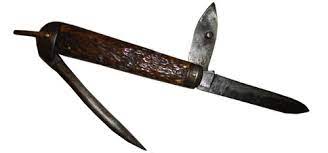
A 6353 Pattern knife made by Camillus (New York) in 1915. Despite American Neutrality, U.S Companies manufactured material for the Triple Entente and provided these goods via Canadian subsidiaries or secret shipments to England.
Pattern 317
The 6353 pattern knife was 4 7/8 in long, folded making it a very large framed knife. While the big blade was handy it was also cumbersome and heavy, especially for a pocket knife. New pattern knives developed in the the 1930s were shorter, typically measuring around 4 inches in length, depending on the manufacturer, with 3 3/4 inches being the norm. This knife is known as the Pattern 317 and was accepted by the British Admiralty perhaps as early as 1933 but more likely in 1939. It consists of a frame with a sheepfoot blade, split blade can opener and Marlin spike. It also features a flat head screwdrivever integrated into the head of the knife. The pattern was approved for service by the UK Ministry of Defense in time for WWII and was pressed into service with numerous UK cutlery companies making the knives. Different companies often applied their own pattern number to the knife and as the companies were all tooled differently the length and other minor details vary slightly from company to company. Those marked with a WD or an Arrow head were made to fulfill a Military contract, however thousands were made for use by the Military and bear no such mark. Several were also made with no distinguishing marks at all and dropped into occupied Europe for use by underground forces. The pattern remained in active use with the British military until 1952 when stainless steel knives became standard issue.
The same pattern was also adopted by Belgium, Italy, and other European contires. Civilian versions were made that lacked the screwdriver and can opener. Versions such as this seemed to have been popular in post war Germany and Eastern Europe.
Sheepfoot blades are rare on pre World War II models but become common place during the war. After the WWII, BMP knives were made almost exclusively with sheepfoot blades. As mentioned the knife was used by all branches of the British Military. While the 317 pattern was determined obsolete in 1952, the pattern continued to be made by Commonwelath nations until at least the 1970s for service use.. The pattern is still manufactured today by various Sheffield cutlers and while not standard issue remains a popular after market knife among civilians, sailors, and soldiers alike.

A 1951 late Pattern MoD three piece clasp knife, approximately 4 inches closed.
U.S.N. Approved
Most American Marlin spikes
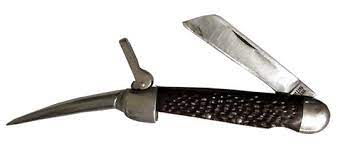
A later pattern American Military Pattern Rigger made by Camillus (New York) probably in the 1970-80s. The knife feaures brwon jigged Delrin scales and the distinctive bail-lock of American knives.
NATO Pattern
Today, the great-great grandson of the 6353/1905 pattern knife is known as the NATO Patterns one, two or three piece clasp knives. (Piece, in fact, refers to the number of blades/implements; with the third piece being a folding marlin spike).
In reality, the knife became standard issue in 1952 and was known as the VN47408 Clasp knife. After very slight modifications it was accepted as a NATO standard and the knife became known as the Knife, Clasp, New Pattern VN21307. This knife replaced the Pattern 317 and 301 knives currently in use by the British Military. (However, various commonwealth nations continued make the older 317 patterns well into the 1970s.)
When I refer to NATO rigging knife, I am referring specifically to what is known today as a "MoD Three Piece Clasp Knife" The one and two piece knives are Rope knives, that is they do not possess a marlin spike.
Known as the 3 piece Army knife, this is the latest in the line of U.K. Ministry of Defense clasp knives with a marlin spike. The latest two piece version lacks the marlin spike but has a locking sheepfoot.
Sailor's Tool
John Myerchin of Myerchin Knife Company developed and patented a sailing knife based loosly on the Multi-Tool design. While Myerchin refers to the knife as workiner's tool other often call it the sailor's tool.
The design concept turns the knife handle and marlin spike into an unusual pair of pliers. The large marlin spike and somewhat short sheep’s head blade are held in the open position with a set of liner locks making this a unique design among sailing knives. Currently only Fury and Meyerchin make knives in this pattern with other companies making Multi-Tool patterns instead.
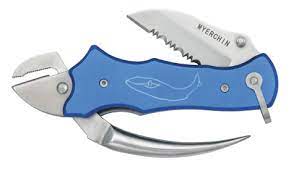
John Mterchin's Sailor's Tool with Blue Scales.
Pattern 301 or Jack Pattern
The Trapper pattern is a sailing knife comprising a main blade and a marlin spike both attached to the top bolster of the knife similar to a traditional trapper or jack knife. The British military pattern 301 clasp knife was a large frame trapper pattern rigging knife.
In these knives, The back blade is a spear or sheepfoot with the marlin spike running in front of it. The obverse side of the handles on these knives is always cut away allowing the spike to rest in a groove. This makes for a more comfortable grip when using the main blade. The pattern seems to have been favored in France and Germany. Companies such as Fox, Eickhorn, and Wichard make modern trapper pattern riggers but often these often employ extra tool blades.

Wichard is one of the few companies recently making sailing knives in a Trapper pattern. Note the cut out in the obverse side of the handle where the marlin spike resides when folded. This particular knife is the Wichard "Glow Knife" marketed as impossible to lose at night due to its florescent handle
Yachtsman
The Original Yachtsman was popularized by Telo and is now primarily made by Davis. There is a standard and deluxe pattern. The Yachtsman is a small knife with a sheepfoot blade and locking marlin spike. The little knives are well made but have few frills. The knives often have the names of marinas or other nautical supply companies embossed or etched on the stainless steel slab sides. The Yachtsman pattern should not be confused with the myraid number of marlin spike knives made by various companies that are named "Yachtsman".
Modern Off-Shore
For lack of better words, there is a sleek knew style of sailing knife that feature better rust resistance, and one hand opening blades and marlin spikes. While several companies make this new breed of nautical knives; as far as I can teel the movement was started with John Myerchin and his Off-shore knives. The knives often feature aluminum or titanium handles and marine grade steels. The designs were driven by private yachtsmen and sailors who wanted something better than the knives typically churned out to fulfill government contracts.
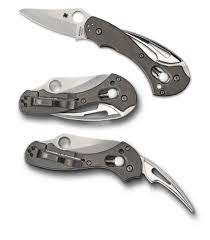 The Spyderco Tusk. A high-end modern rigger featuring
The Spyderco Tusk. A high-end modern rigger featuring
The most common rope knife patterns (click blue text to read entry)
Burma
The Burma pattern refers to a hanlde pattern the has a cut-out near the bail end to allow the user to grasp the blade more easily without the need of nail-nick (pull). In most cases the Burma pattern is slab sided, that is the outer liners act as the knife scales. It is the forerunner to the Modern NATO pattern, however it lacks a marlin spikes.

A Burma one piece clasp knife from around 1945. Made by Ibberson
No. 40
The No. 40 knife was known as the U.S. Navy and U.S.C.G General Utility Knife. It is also often refered to as an EZ Out Jack.
#425
The U.S. Coast guard Approved knife was known as the Q5 or #425 Jack Knife. In 1949 this single bladed knife has a can opener added. It was made by Camillus (1990-1995) , Imperial (1984-1989), F & L Packing Corp (1990-1995), and Dartex Inc (2007-2012). The Dartex models are made in Hong Kong by Goldsell Enterprises, Ltd. While there is debate about it being issued to Coast Guard personnel; personal recollection makes it clear it was used by members of the USCG and the Merhcant Marines.

A Schrade rope knife with Delrin® (imitation wood grain) scales
Hawkbill
In reality, the Hawkbill is a cousin to the Rope knife. It is also called a pruner, hookbill, or simply Hawk. It features a hook shaped blade that resembles that of hawk; hence the name. The hawkbill design is designed to cut by pulling the blade through material. It is probably more useful used on a loose bite of line. It is also ideal for pruning branches, cutting carpet, linoleum and light wieght wire. The tip is also good at scoring lines. Sailors tend to prefer a locking blade and handle with a bail or lanyard hole. The downfall of the hawkbill is the curved blade which make it more difficult to sharpen and harder to baton.
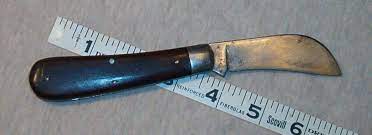
A older hawkbil knife made by the Hardware store Hibbard, Spencer & Bartlett
Nautical Rescue
Nautical Rescue knives comprise the numerous tactical style knives that normally have a single locking sheepfoot, hawkbill, or wharncliffe style blade. These are the latest incarnation of the oldest of nautical knives, the rope knife. Unlike tradional slip joint pocket knives, the tactical knife usually rely on a liner or frame lock, saftey catches or other device to keep the blade in the open or closed position instead of a back spring. The handles are normally slab sided and often held together by screws or small bolts. What makes these knives different than regular search and rescue knives if the use of steel and other alloys that are resistant to salt water damage.

Advertising photo of the Spyderco Tusk, A marine rescue knife.






 The Spyderco Tusk. A high-end modern rigger featuring
The Spyderco Tusk. A high-end modern rigger featuring

 A older hawkbil knife made by the Hardware store Hibbard, Spencer & Bartlett
A older hawkbil knife made by the Hardware store Hibbard, Spencer & Bartlett